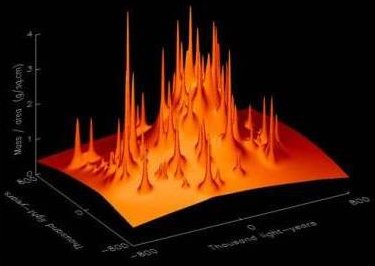

For a few centuries, physicists were comfortable with our laws of gravity. Then, something interesting happened in the 1900s, as astronomers measured the rotational speed of galaxies. Something was immediately wrong since the outer regions of the galaxy were orbiting around the galactic nucleus at a much faster pace than they should. In fact, galaxies tend to rotate so quickly that, taking into account gravitational interactions from all visible matter, they should fly apart. Along the same line of thinking, galaxy clusters pose exactly the same problem but on a much larger scale. It’s not uncommon to see galaxies zipping around at much quicker speeds than they should be traveling. Taking into account the laws of gravity and the protons, neutrons, and electrons we see, galaxy clusters should also fly apart as the galaxies travel above the cluster’s escape velocity.
Obviously, since galaxy clusters remain intact and galaxies remain coherent, one of two things is wrong. Either there is more mass present in these objects than we are able to conventionally detect (this extra gravity has been affectionately named “dark matter”) OR the laws of gravity are off and need to be modified/fixed accordingly.
Now, the real question is, which is it? Fortunately, there’s a test for that.
Today, our battery of tests have weighed pretty heavily on the ‘dark matter’ side of the equation. One of the champions here is watching the effects of gravitational lensing. Gravitational lensing was originally predicted by Einstein in his theory of relativity, and later confirmed within our own solar system. This trick of space-warping has been instrumental in helping us map the large scale structure of space.

Now, as normal matter collides, it exchanges information in the form of energy and momentum. Dark matter doesn’t do that. Dark mater just passes through…kind of like that one weird fellow in old westerns who usually ends up dead. Gravitational lensing, on the other hand, doesn’t change. Dark matter still warps spacetime and that effect can be observed by looking at the distorted light from background galaxies.
In addition to gravitational lensing, scientists have used clustering statistics and measurements in fluctuations in the cosmic microwave background to make a case for dark matter. So, dark matter exists. Case closed. Right? Not quite.
Ethan Siegel from the National Geographic put it best when he said, “In science, even when you’re convinced that you know the right answer, you keep testing your understanding in new ways. You keep looking for phenomena that might do something different than what your best ideas and theories predict. As long as there’s a Universe out there to investigate, science doesn’t end.”
This is where gravitational redshift comes to the rescue. In a dark matter universe, dark matter helps to create a greater gravity well. The deeper your gravity well, the harder it is to climb out. If galaxy clusters are full of dark matter, light should have a harder time escaping the cluster and lose energy in its wavelength, causing it to undergo a red shift. Without dark matter, we should see something else entirely.
A team of scientists from the University of Copenhagen set out to test this prediction. Using data from the Sloan Digital Sky Survey, the team first needed to run tests to confirm that the galaxies in the clusters were indeed gravitationally bound with each other (in addition to running tests to make sure such a thing was observable). After tying up the loose ends, it was time for the highlight of the show – measuring the redshift.

Long story short? The data came back confirming that General relativity with dark matter and dark energy are the best fit in comparison to other theories. Along the same lines, the TeVeS hypothesis attempts to do away with dark matter entirely; the data collected by the Copenhagen team delivers another fatal blow to that idea.
So, it looks like that our idea of gravity and the concept of dark matter will live to fight another day.